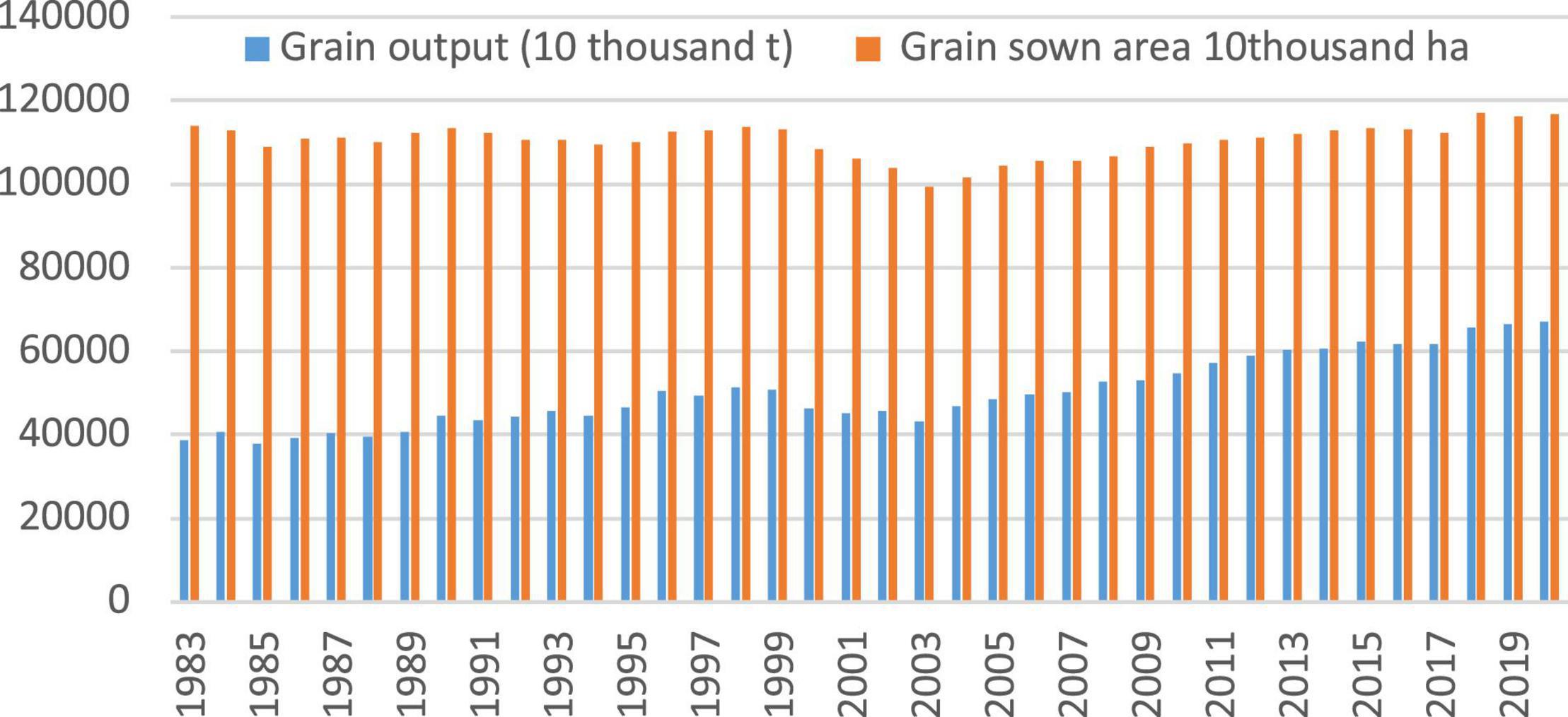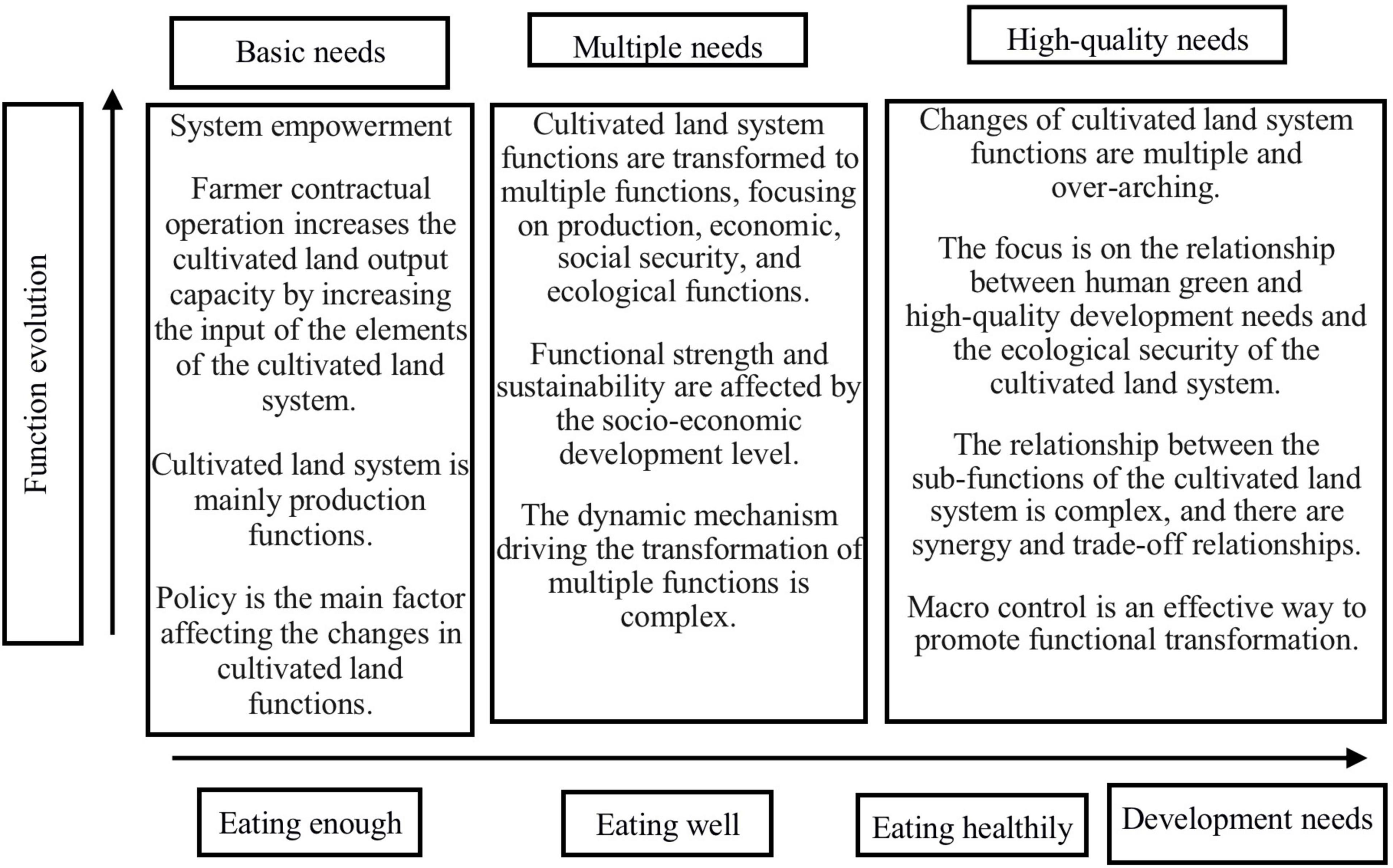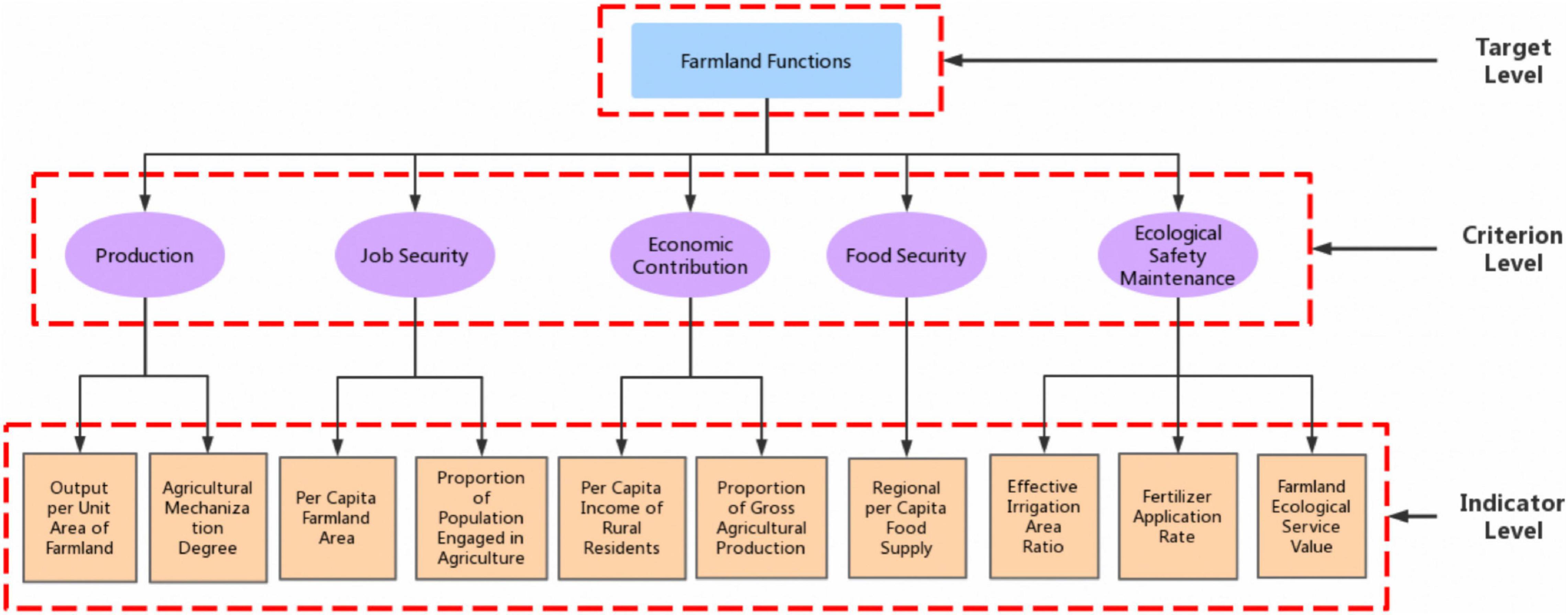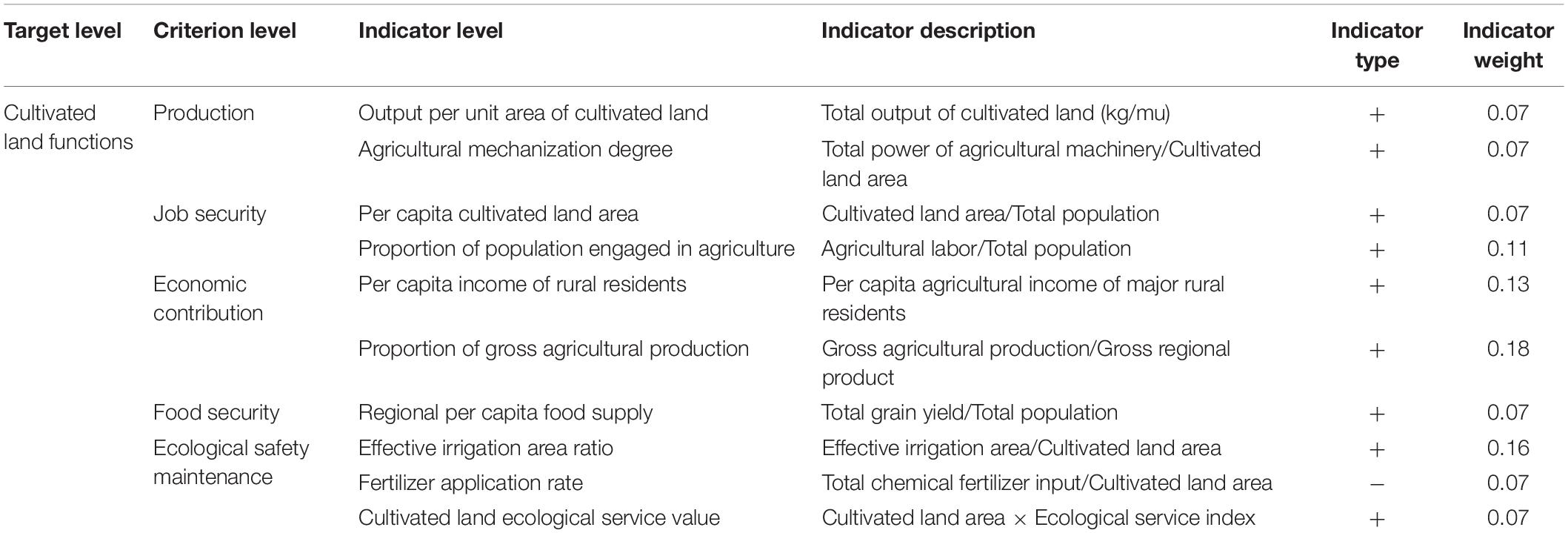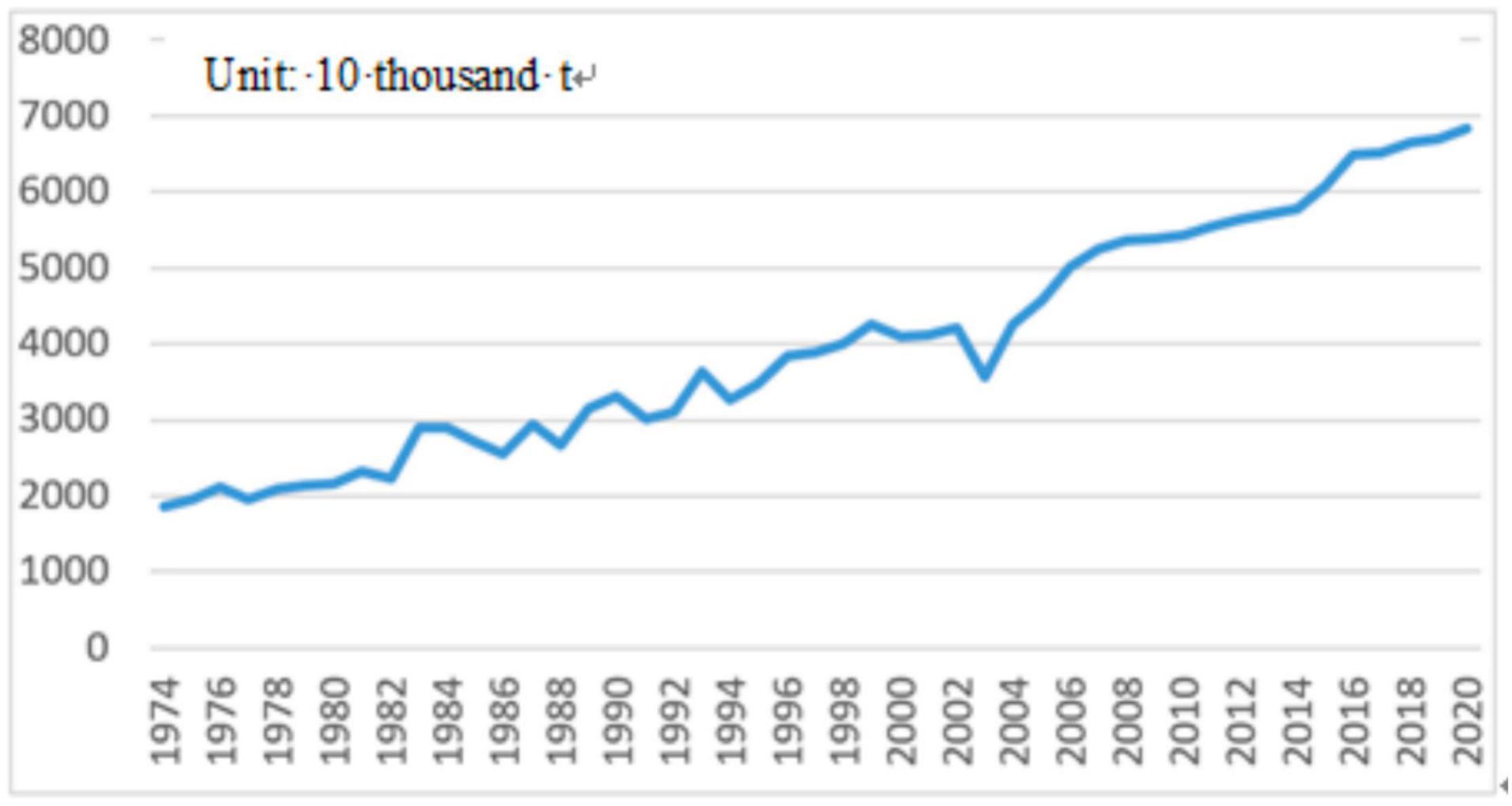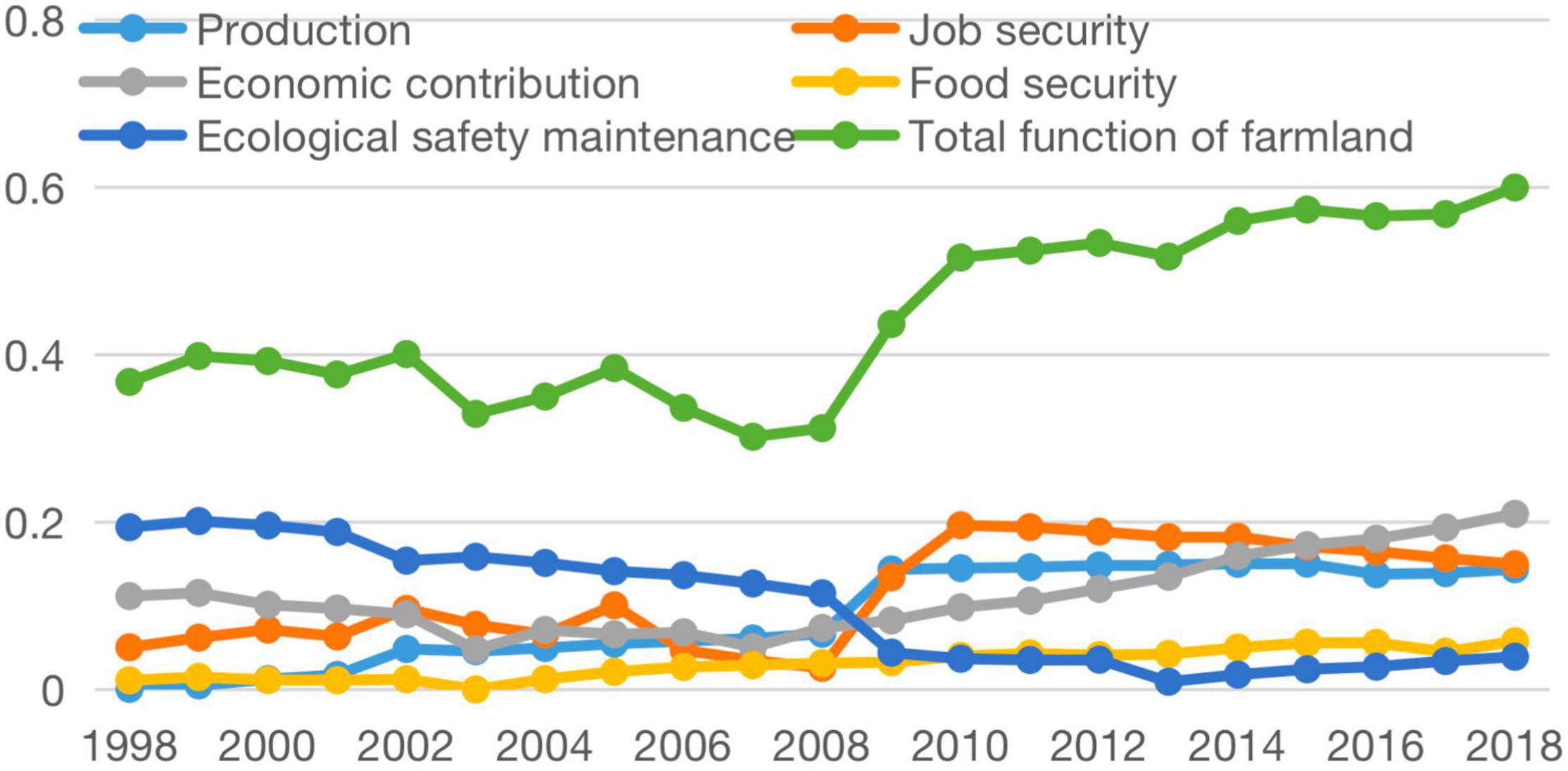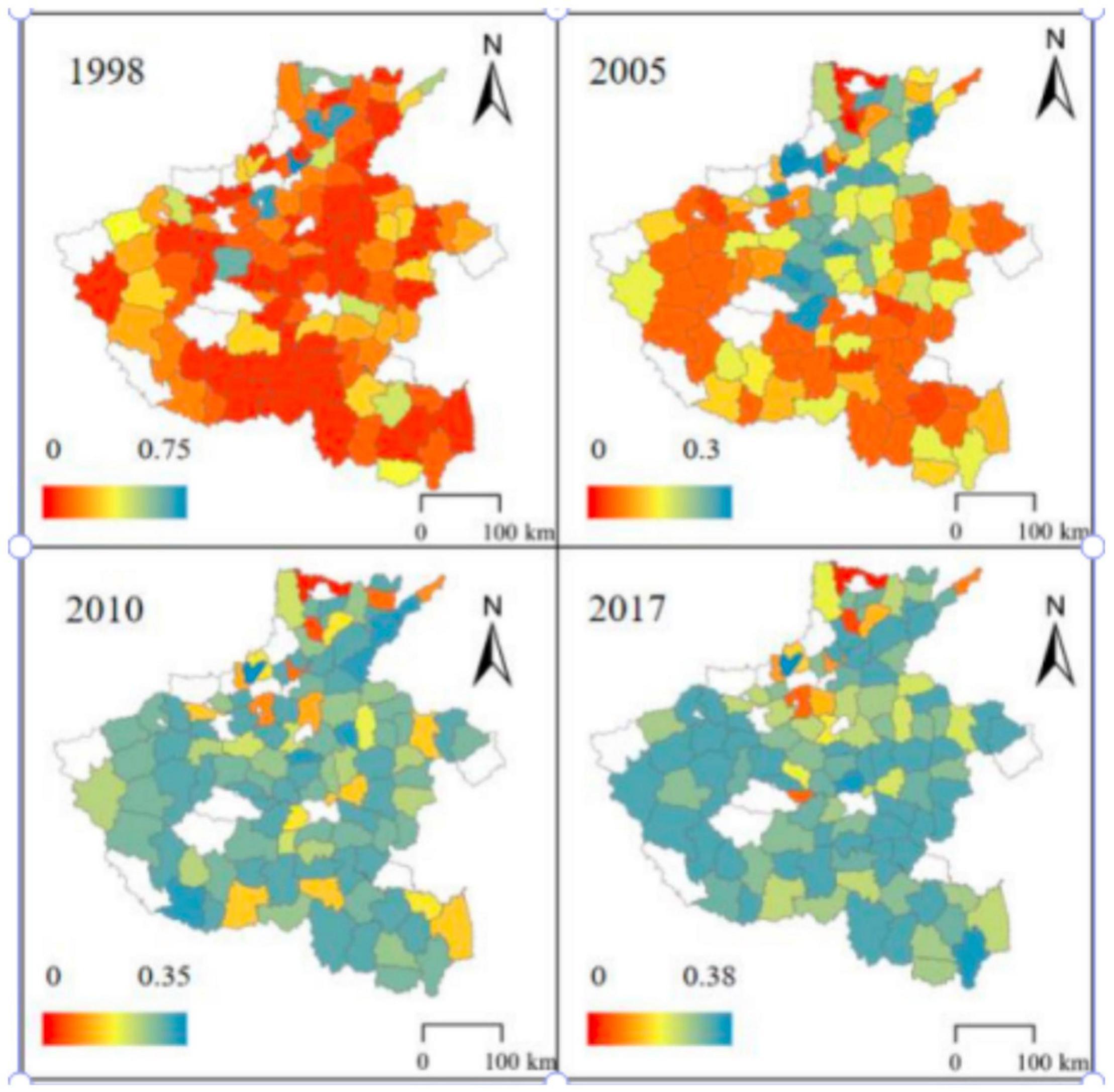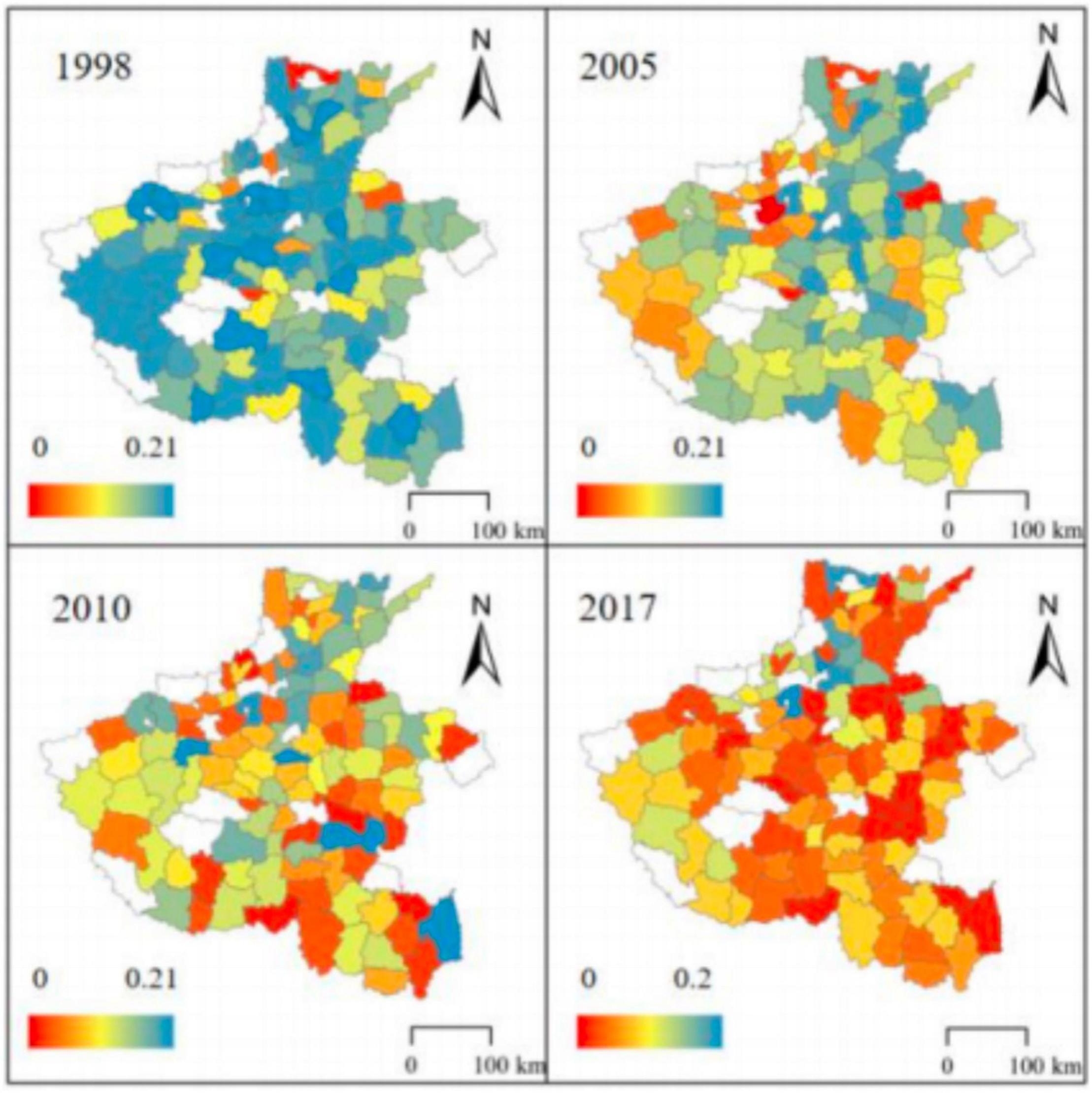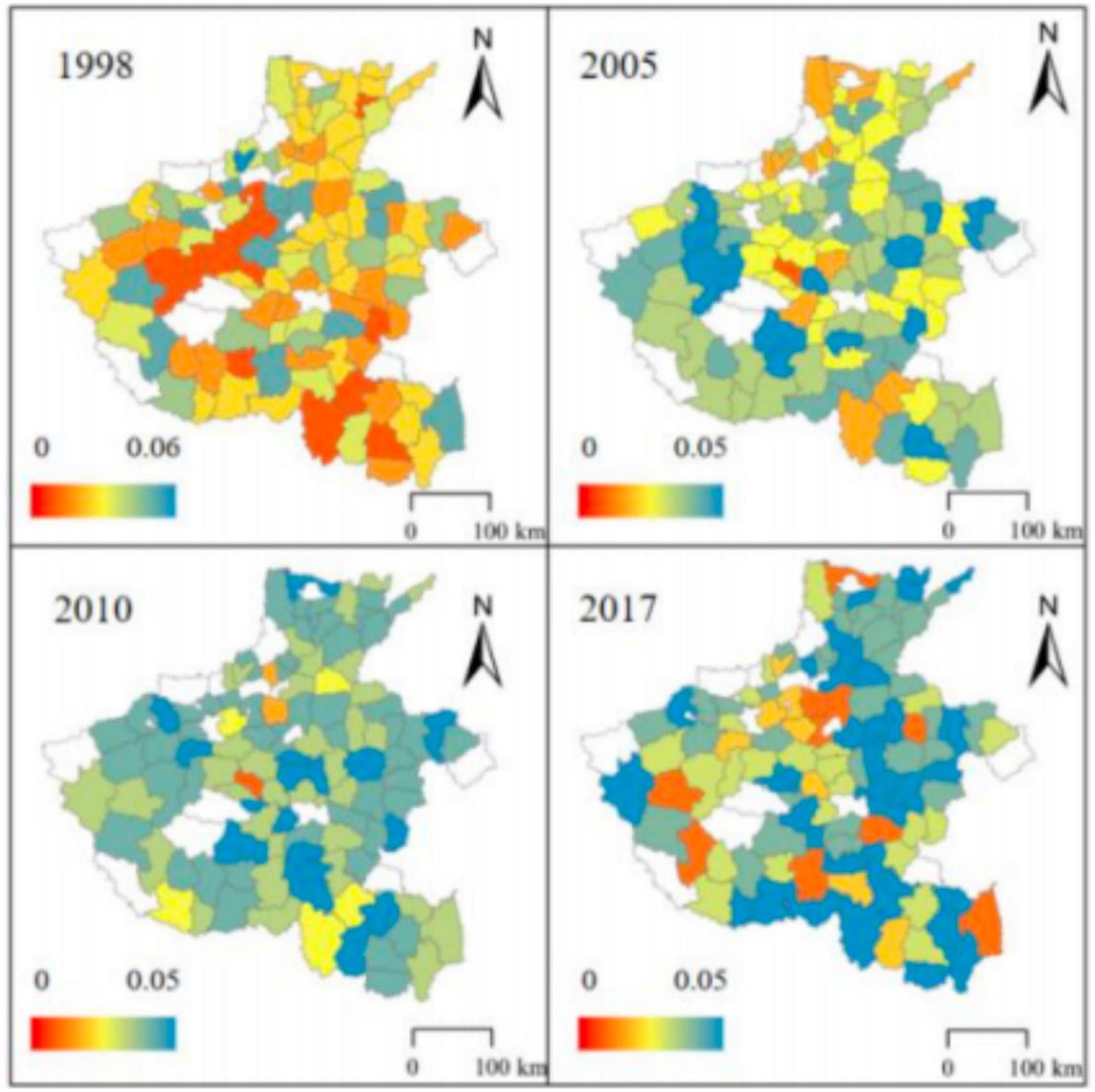- 1Center for Chinese Rural Studies, Central China Normal University, Wuhan, China
- 2School of Geography and Environmental Science, Henan University, Kaifeng, China
- 3National Demonstration Center for Environmental and Planning, Henan University, Kaifeng, China
Cultivated land is a compound social-ecological system with the highest dependence on human beings. With changes in human demand, the function of the cultivated land system has undergone profound transformation. In this study, we analyze the development and evolution of cultivated land system functions, with the aim of providing decision-making support for national macro-management. Drawing on social-ecological system theory, and using multi-factor comprehensive analysis, ArcGIS spatial analysis, and a gray correlation model, this research evaluates the multifunctional temporal and spatial differences in the cultivated land system in 113 counties in Henan Province, China and analyzes their driving factors. The results show that: (1) the overall function of the cultivated system in Henan Province has obvious stage characteristics over the past 20 years, with the cultivated land function index being low from 1998 to 2013, and gradually increasing after 2013; (2) the trend of the cultivated land function has a progressive character, with the function index fluctuating from 0.3 to 0.6; (3) There is an obvious hierarchy among the sub-functions, showing the public role of production function, economic contribution function, employment guarantee function, food security guarantee function, and ecological security maintenance function; (4) Coordination analysis shows that there are trade-offs and synergies between sub-functions and the overall functions of the system; (5) Gray correlation analysis shows that urbanization, industrialization, agricultural modernization and agricultural policies play an important driving role in the evolution of cultivated land functions. These results not only provide a methodological and scientific basis for the evaluation, management and decision-making of cultivated land systems, but also provide a theoretical exploration of how the transformation of cultivated land goals can be integrated with sustainable development goals.
Introduction
In 2017, the Chinese central government implemented a higher quality development strategy, of which improving the quality of agriculture and enhancing rural development capacity is one of the key components. This is due to the growing uncertainty in food production, both domestically and internationally, since 2013, as the population’s food consumption structure has been upgraded, climate change and depletion of soil and water resources have had an impact. Vulnerability, risk and transformation of cultivated land system functions have become key research areas for the international sustainable development goals and China’s cultivated land conservation targets. However, China’s per capita cultivated land area has halved in the last 45 years (Wang et al., 2018), and cultivated land resources have been plundered by multiple demands and become scarce (Mertz and Merens, 2017), which in part hinders the achievement of Sustainable Development Goals (SDGs) including responsible consumption and production, zero hunger, health and well-being, and reduction of inequality. Therefore, how to shift from a focus on resource conservation to enhancing the functional value of resources? How to improve the function of cultivated land systems is an important issue related to whether the international SDGs and China’s cultivated land conservation goals can be achieved (Schlager and Ostrom, 1992; Spalding, 2017; Wang et al., 2018).
Cultivated land is a complex social ecosystem with the highest degree of human dependence. The function of cultivated land tends to be diversified to meet the development needs of human society (Song and Ouyang, 2012). However, previous research has tended to focus on the relationship between cultivated land system functions and land policy (Jepsen et al., 2015; Liu et al., 2017; Spalding, 2017). However, it has failed to provide a thorough explanation of why changes in cultivated land use may conflict with policies for the use of cultivated land (Liu et al., 2017), and researchers still know very little about the link between land policy and changes in the functions of cultivated land (Jepsen et al., 2015; Spalding, 2017). In particular, only a few scholars have discussed the internal relationship between food demand and changes in the functions of the cultivated land system from the perspective of land-use strategy. Therefore, this study focuses on the dynamic balance and spatial coordination between the social and ecological systems of cultivated land, and aims to develop a framework to interpret the functional changes of the cultivated land system in different stages of social and economic development. To achieve this aim, it addresses the following questions: What are the trends in changes in various functions within the cultivated land system? What are the factors driving changes in the functions of the cultivated land system? The answers not only provide a methodological and scientific basis for assessment, management, and decision-making in the cultivated land system but also clarify the change process and driving mechanism of the ecosystem service function under different land-use types.
Function Evolution and Construction of Theoretical Framework
Based on the characteristics of the relationship between people and land at different stages of development, the objectives and paths of cultivated land conservation in China are constantly being optimized. The functions of the cultivated land system change as the objectives of cultivated land conservation change: along with the staged, multi-level and progressive needs of urban and rural residents, the functions of the cultivated land evolve in a diversified manner with different primary and secondary functions. Specifically, the stages are characterized by a clear change in the objectives of cultivated land conservation from eating enough to eating well to eating healthily at different stages of economic development. The hierarchy corresponds to the change from single to multiple functions of the arable land system, i.e., from purely resource supply protection to the synergistic protection of resource function and value supply and demand; the gradual transformation from the current “three-in-one” protection of arable land in terms of quantity, quality and ecology to the “five-in-one” goal of arable land in terms of quantity, quality, ecology, function, and value.
Function Evolution of a Cultivated Land System Based on Needs
Cultivated land is a natural complex with multiple functions, and cultivated land system functions evolve with the needs and regional differences of urban and rural residents (Zhao et al., 2007). Previous research (Zhao et al., 2007; Jiang et al., 2011) on cultivated land system functions has focused on staple food production, conducting theoretical analysis on the multifunctionality of agriculture from an economic perspective and concentrating on the value status of agricultural functions (John et al., 2013). The functions of the cultivated land system change with the different stages of social and economic development, which follow the staged, multi-hierarchical, and gradual needs of urban and rural residents. Staged needs are manifested as the evolutionary development of life needs at different stages of economic development in terms of having enough to eat, being able to eat well, and being able to eat healthily. Based on the national grain output and per capita grain demand, this paper divides the functional change of cultivated land into four stages, namely insufficient basic need stage (before 1978), basic need stage: (1978–2000), multi-need transformation stage (2000–2013), and high-quality need stage (since 2013). Hierarchical needs correspond to the change from single to diversified cultivated land system functions (Jiang et al., 2011). Finally, it should be noted that there are significant regional differences in the cultivated land system functions.
Basic Need Stage: Having Enough to Eat (1978–2000)
Before the 2000s, the production function of the cultivated land system played an important role in meeting people’s basic needs. Since the early 1980s, China had empowered the cultivated land system through the reform of the land system; farmers obtained the right to possess, use, and retain part of the income from cultivated land through the household contract responsibility system (Kong, 2016). This reform allowed farmers to make their own decisions on crop varieties and scopes, which strengthened their enthusiasm for agricultural production (Han, 2019). Taking data from national statistics, we analyzed China’s gross output value of agriculture and per capita food output and found that, before 1978, per capita food output was always lower than 340 kg, thereby remaining in a low-level production state that cannot meet people’s most basic life needs. However, following the reform, agricultural production developed rapidly. In 1983–2000, the national crop sown area reached about 11,000 billion ha. In 2000, the total national grain output reached 462.17 million t, an increase of 94.89 million t from 1983, as shown in Figure 1.
In the middle of the 1990s, because of the instability of cultivated land contract rights and the continuous changes and reforms of the rural economic and political system, farmers lacked a sense of security in relation to land-use rights and were failing to form long-term investment expectations. They had to choose short-term or reduced cultivated land fertility operation methods (Feng et al., 2013), which led to a stagnation of total grain output. After 1994, with the implementation of the land policy of “increasing people without increasing land and reducing people without reducing land” and measures including reform of taxation expenses in most regions, national grain output rose steadily. However, due to the impact of rural industrialization, a large amount of high-quality cultivated land in the eastern region was occupied, and grain output dropped for a time. Nevertheless, after more than two decades of rural land system reform, the problem of providing adequate food and clothing, which plagued China for many years, has finally been resolved. During this period, optimization of the cultivated land-use policy has become the best way to improve the living standards of farmers (Yuan et al., 2007).
Multi-Need Transformation Stage: Being Able to Eat Well (2000–2013)
Since the 2000s, the functions of cultivated land have been transformed from the original function of staple food production to the functions of diversified production and security. This is because people’s demand for an improved quality of life is increasing rapidly. However, both rural villages and agricultural developments have faced difficulties because of a lack of labor and cultivated land. In addition to the reduction of the scale of cultivated land, a large amount of rural labor has moved into secondary and tertiary industries because of rapid urbanization and rural industrialization. In 2005, China completely abolished the agricultural tax, and in 2007, the No. 1 central document proposed a series of agricultural policies such as “industry nurturing agriculture” and the “vegetable basket project” under the responsibility of local leader. The purpose of these policies is to stabilize grain production and ensure that people’s growing substantial needs are met. Driven by these two goals, agricultural production achieved diversified development, and the outputs of grain, oil, fruit, and vegetables was comprehensively increased. Cai and Huo (2006) has argued that, to reflect the social security capacity of cultivated land, a standardized rural social security mechanism and social equity mechanism should be established through the transfer of cultivated land operation rights. By studying the relationship between the consumption demand of Beijing urban residents and the function of cultivated land, Zhao et al. (2007) found that residents’ consumption of grain, meat, poultry and related products, and vegetables declined continuously, while consumption demand for high-protein, low-fat milk and dairy products, prestigious high-quality dried and fresh fruits, and aquatic products increased significantly. More attention was being paid to the quality of agricultural products, as well as to the tourism and leisure functions of cultivated land, reflecting an increasing focus on improvement of the quality of life and increased spiritual enjoyment.
High-Quality Need Stage: Being Able to Eat Healthily (Since 2013)
Since 2013, the idea of ecological civilization has been a deeply rooted concern. People’s pursuit of a higher quality of life has intensified, and there is strong demand for organic products, pollution-free ecological products, and green food. Thus, the Chinese Central Government has implemented a higher-quality development strategy for improving the quality of agriculture and empowering rural development. The functions carried by cultivated land have also been further transformed, with a focus on the conservation and construction of cultural and ecological functions. Cultivated land should not only provide sufficient grain yield but should also meet people’s growing need for high-quality development through green construction. Existing research has made useful explorations of the interaction of sub-functions of cultivated land (Du et al., 2016), the driving mechanism of cultivated land functions (Qin et al., 2018), the evolution and prediction of cultivated functions (Zhang et al., 2021), and the coordination and management of cultivated functions. Since 2013, the contradiction in agricultural production has changed from an insufficient total amount to the coexistence of excess of supply over demand and insufficient supply. Therefore, multifunctional agricultural development and cultivated land raise following requirements: adjusting the agricultural production structure; accelerating the development of diversified, advantageous, and multifunctional agriculture; continuously improving the quality and efficiency of agriculture; and meeting people’s needs for a healthy and green life.
Connotation and Classification of Cultivated Land System Functions
Evolution of Cultivated Land System Functions
Cultivated land system functions are the functions of meeting the needs of human production and life, the different roles of cultivated land in different stages of economic development, and the ability of the cultivated land system to provide various products and services that meet the needs of human existence and development. The concept of multiple cultivated land system functions originated from the multiple functions of agriculture, as formally confirmed by the United Nations in 1992 (Song and Ouyang, 2012). In 2004, the sixth framework project of the European Union set out the concept and analysis framework of multifunctional land use. In 2021, the United Nations Food and Agriculture Organization defined the sustainable goal of land function as “ensuring food security, improving nutrition and ensuring everyone can afford a healthy diet” (FAO, 2021), noting that multifunctional land use is the state and manifestation of regional land-use function and its environmental, economic, and social functions, and an important theoretical and methodological system for evaluating the impact of land-use change on its functional sustainability (Zhen et al., 2009). Multifunctional land use is the state and performance of regional land-use function and its environmental, economic, and social functions, and it is an important theoretical and practical system for evaluating the impact of land-use change on the sustainability of its function (Cai, 2001).
Relationship Between and Classification of Cultivated Land System Functions
Cultivated land function is the carrier of cultivated land quality, and the connotation of cultivated land quality is continuously enriched by the increase of needs for functions. The multiple functions of cultivated land come from the diversity of regional development goals, the diversity of social needs, and the versatility of land use (Liu et al., 2011). The functions of cultivated land can be summed up as economic contribution, food production, social security, and ecological services (Wang et al., 2020). In 1999, Japan promulgated its Basic Law on Food, Agriculture and Rural Areas which classified cultivated land functions. This law emphasizes that, in addition to economic functions, cultivated land also has multiple social, ecological, and political functions (Cai, 2001), including water conservation, flood control, soil conservation, prevention of landslides, degradation of organic waste, air purification, climate regulation, and leisure and health care. The Organization for Economic Co-operation and Development (OECD) also argues that cultivated land functions should include the ecological environment, food security, social stability, and rural cultural functions. Yoshida et al. (2019) divided cultivated land functions into three categories: economic output, social security, and ecological functions. Wiggering et al. (2006) divided cultivated land functions into production, filter buffer, gene banks, and biological habitat functions. On this basis, Herzon and Helenius (2008) divided cultivated land functions into four types: production, carbon sequestration, water purification, and biological habitat. The previous research discussed above has shown the diversity of cultivated land functions. However, a systematic framework is needed to understand the roles of different functions.
Cultivated Land System as a Complex Social-Ecological System
Cultivated land is a complex social-ecological system (SES) that carries human activities, and human beings depend on the SES for survival. Social-ecological systems SES form an organic whole through the interaction of material cycles and energy flows in a certain spatial and temporal context. This system is made up of ecological and social subsystems, which do not have static relationships with each other, but rather interact with each other and evolve together (Berkes, 2000). Holland (1994) and Cumming (2011) have pointed out that the SES includes social, economic, and ecological subsystems, which have the ability to adapt and learn to the environment, and that changes and coordination within the system form a dynamic and stable hierarchical structure. The cultivated land system is one of the subsystems embedded in the social-ecological system, the social-ecological system that carries the most profound human activities, a dynamic and complex system driven by the interaction of the social system and the ecosystem, forming a multi-factor, multi-level and multi-functional system (Berkes et al., 2000; Walker et al., 2002; Zou et al., 2021). The social system in the cultivated land system structure refers to human society and forms the core structure of human survival and activities; the ecological system in the cultivated land system structure is composed of soil, living things, and the non-living parts of water and air, and it is the result of human intervention over thousands of years.
Cultivated land system functions are derived and evolved from the SES structure and can be divided into basic functions and derivative functions. The basic function meets the low-level life needs of human beings in terms of having enough to eat, while the derivative function meets the diverse needs of human beings that is, being able to eat well and healthily. The syntegration of the two functions is the ultimate direction for meeting the needs of urban and rural residents (Zhao et al., 2007; Song and Ouyang, 2012). Zhang et al. (2018) extended their enquiry from the evolution of the secondary sub-functions of cultivated land to the exploration of the evolution of the multifunctional and integrated functions of cultivated land resources. By constructing an evaluation indicator system, Yang and Tan (2014) and Chen et al. (2021) quantified the multiple functions and evolutionary trends of cultivated land. Using a multi-dimensional evaluation model, Gómez Sal and González García (2007) evaluated the ecological, production, economic, cultural, and social functions of the Spanish agricultural land-use system. In terms of spatial scale, existing research has analyzed the temporal and spatial characteristics of the evolution patterns of the multiple functions of cultivated land (Luo and Cai, 2016; Meng et al., 2021). The safety of cultivated land safety has also attracted much attention. Kuang et al. (2018) and Li and Dong (2019) diagnosed obstacles and driving factors that affect cultivated land safety. Qin and Wang (2020) conducted a study on the optimal allocation of safe usage and early warnings in relation to cultivated land safety. Zhu et al. (2020) analyzed the practical path of the multifunctional management of cultivated land in China.
Achieving a win-win situation for both sustainable development goals and cultivated land conservation goals requires proper management of the relationship between population, society, economy and resources, and respect for the integrity and inherent laws of social-ecological systems (Liu et al., 2011; Qin et al., 2018; Zhang et al., 2021). It also requires balancing the current needs of high-quality human social development on the basis of making full use of natural ecological values and integrating the conflicts and synergies of multiple functions in the use of cultivated land systems (Shi et al., 2015; Zou et al., 2020). However, few studies have focused on the relationship between human and cultivated system structure and functions from the perspective of SES theory. Through the interpretation of changes in the functions of the cultivated land system in different stages of social and economic development, this study attempts to argue that the dynamic balance and spatial coordination between the social and ecological systems of cultivated land could be an important principle for measuring regional sustainable development.
Conceptual Framework
This study focuses on how people’s high-quality life needs affect changes in the cultivated land system functions in the context of the current high-quality social and economic development, and on the reasons and mechanisms driving the changes in the cultivated land system functions (Figure 2). Using multi-factor comprehensive analysis, ArcGIS spatial analysis, and a gray correlation model, and taking Henan Province, a major grain production province in central China, as the research object, we constructed an indicator system for the functions of the cultivated land system based on county administrative unit (Figure 3). The statistical analysis focuses on the changing characteristics of cultivated land functions during the transition period from “eating well” to “eating heathy” (1998–2017), and the analysis of the driving factors affecting cultivated land functions, and the exploration of the synergies and trade-offs between different functions, with a view to providing policy support for the spatial optimization and control of national land resources. Finally, we explored the synergy and trade-off relationships between different functions, to provide policy support for the optimization of space management and control of national land resources.
Research Methods and Data Sources
Overview of the Study Area
Taking 113 counties in Henan Province as the research object, we evaluated the functions of the cultivated land system in the province. As an important is of China for agriculture, grain production, and population, Henan Province produces 1/4 of China’s wheat and 1/10 of its grain, with 1.73% of the country’s land area and 1/16 of its cultivated land area. In 2020, Henan Province had 8.0233 million ha of cultivated land, and its annual total grain yield was 68.258 billion kg. The total grain yield has remained above 55 billion kg for the 15 consecutive years since 2006. This yield not only addressed the food needs of more than 100 million people in Henan Province but also allowed the transfer of 20 billion kg of raw grain and processed products every year, thereby playing a particularly important role in China’s national food security.
Within the total output value of agriculture, forestry, animal husbandry, and fishing in the proportion of the planting industry was declining gradually, whereas that of forestry, animal husbandry, and fishing continued to increase. Since the reform and opening up, Henan Province has introduced policies and measures to encourage the development of diversified operations and to promote agricultural industrialization. As a result, agricultural production and operation have gradually diversified. Particularly since the 18th National Congress of the Communist Party of China, the policy system for strengthening and benefiting farmers has been improved, the structural reform of the agricultural supply side has been deepened, and the structure has been adjusted and optimized. The planting area of high-quality peanuts reached 1,203,200 ha, the largest in China. The output value of the top ten superior and characteristic agricultural bases in the whole province reached 434,337 billion yuan, accounting for 56.0% of the total output value of agriculture, forestry, animal husbandry, and fishing in the province. Furthermore, the provincial agricultural production level has been greatly improved, and the output of major agricultural products such as grain, vegetables, fruit, oil, and meat has continued to increase, providing a solid material foundation for the continuous improvement of living standards. In 2018, the province’s output of vegetables and edible fungi was 72.67 million t; its outputs of oil and fruit crops were 6.3105 million t and 9.0739 million t, respectively; its total outputs of meat, poultry and eggs, dairy products, and aquatic products were 6.6268 million t, 4.1361 million t, 2.0265 million t, and 0.9838 million t, respectively.
Data Sources
For this study, cultivated land data were mainly obtained from the Middle and Lower Reaches Yellow River Branch of the National Earth System Science Data Center of the Chinese Academy of Sciences, the 2000–2019 Henan Statistical Yearbook and the statistical yearbooks of counties and cities (districts), the 2000–2019 Land and Natural Resources Bulletin, the 2000–2019 Henan Bulletin of Soil and Water Conservation, the statistical bulletins of Henan Province and counties and districts, and government work reports. The data were collected on site, from various functional departments of Henan Province, or through interviews. In particular, Zhengzhou Municipal Bureau of Natural Resources and Planning provided land-change survey data and related document reports for 2000–2019; the Agriculture Bureau of Henan Province and each city provided information on agricultural production, agricultural disasters, and disaster prevention in the years concerned; and relevant studies and research reports provided support for the data collection and analysis.
Selection of Evaluation Indicator Factors
Through our overall survey of the existing basic conditions of cultivated land and the functional needs of local residents, we constructed an evaluation indicator system for the functions of the cultivated land system in Henan Province. Given the availability of data and the difficulties of quantification, and in accordance with established scientific, systematic, and hierarchical principles (FAO, 2021), we established an evaluation indicator system covering the production, job security, economic contribution, food security, and ecological safety maintenance functions of cultivated land system, as indicated in Table 1.
(1) The production function refers to the ability of cultivated land, as the fundamental means of production. The area of cultivated land and the degree of agricultural mechanization are used as indicators for the production function. (2) The job security function is an administrative measure taken by the state to create employment conditions and expand employment opportunities by relying on land in order to guarantee citizens’ realization of their labor rights. The area of cultivated land per capita and the proportion of the population engaged in agriculture are used as indicators of the employment security function provided by the cultivated land system. (3) The economic contribution function refers to the output efficiency developed on the basis of the capital and labor invested in the cultivated land system. This function can be expressed at the micro level through the agricultural income of rural households; at the same time, as a basic means of production, cultivated land can also be expressed at the macro level in terms of its output efficiency in terms of its contribution to the gross national economic product. Therefore, the per capita agricultural income of rural residents and the share of agricultural GDP are selected to characterize the economic contribution function of the cropland system, respectively. (4) The food security function refers to the ability of arable land to secure the food needs of the population in a given region through its production function [24]. Therefore, the regional per capita food supply was selected to express the food security function of arable land. (5) The ecological security maintenance function refers to the role of arable land in maintaining soil health and ecological balance. David Pimentel has pointed out that the excessive use of pesticides and chemical fertilizers has led to a higher rate of land loss than land replenishment on arable land worldwide; at the same time, irrigation has a direct impact on the quality of the land [25]. Therefore, the ratio of fertilizer application to effective irrigated area was chosen as an indicator factor for the ecological security maintenance function, and the ecological service value of arable land was valued with reference to the ecological service value per unit area equivalent factor of Chinese ecosystems.
Research Methods
Determination of Index Weight
In this study, subjective and objective methods were used to determine the weight of each index. The objective weighting method adopted the entropy method, and the subjective weighting method adopted the analytic hierarchy process. For the analytic hierarchy process, we invited relevant experts to compare the evaluation indexes of cultivated land system function pairwise and to score them layer by layer, building a judgment matrix of target layer and criterion layer, and criterion layer and index layer. On this basis, we used the square root method in Yet another AHP software to find the largest characteristic root of the judgment matrix and its corresponding characteristic vector. Since the consistency test was passed, the calculated feature vector was taken as the index weight (Zhang et al., 2021), and the weight vector Wp was as follows:
The objective weighting method is to determine the weight of the index according to the amount of information contained in the index data. In this paper, the entropy weight method is used to determine the entropy weight Wq of each index through calculation, which is expressed as follow:
The average weight of Wp and Wq, i.e., Wi = 1/2 × (Wq+Wp), is combined to determine the weight Wi for each indicator of cropland ecosystem function, expressed as:
The results are shown in Table 1.
Calculation of Function Index
A multi-factor weighted integrated model is used to calculate the Cultivated Land Multifunctional Index. The greater the Cultivated Land Multifunctional Index, the better the functional status of the cultivated land and the greater the sustainability of the cultivated land system. The calculation formula is as follows:
where F(pro), F(job), F(econ), F(food), and F(ecol) denote the production function index, job security function index, economic contribution function index, food security function index, and ecological function index, respectively. w(pro)i, w(job)i, w(econ)i, w(food)i, w(ecol)i, f(pro)i, f(job)i, f(econ)i, f(food)i, and f(ecol)i are the weights and standardized evaluation index values of the ith index of the production, job security, economic contribution, food security, and ecological functions of cultivated land. F(pro), F(job), F(econ), F(food), and F(ecol) are in the range 0–1; the higher the value, the stronger the corresponding function.
Calculation of Coordination Degree
From the perspective of system theory, there are conflicts, trade-offs and synergies between the five sub-functions and the total functions of cultivated land. However, since they cannot be analyzed in quantitative form, the coordination analysis method is introduced to analyze the conflicts and synergies between the sub-functions and the total function. The formula is as follows:
In the above formula, Di is the coordination coefficient of the ith sample; Ti is the standard deviation of each criterion level value for the ith sample; and Pi is the mean of each criterion level value for the ith sample.
The coordination theory holds that the coordination degree C is between 0 and 1, and when C ≥ 0.8, the coordination degree is extremely high, and each index factor of cultivated land function is highly coordinated; When 0.6 ≤ C ≤ 0.81, each index factor of cultivated land function is relatively coordinated; When 0.4 ≤ C ≤ 0.61, each index factor of cultivated land function is moderately coordinated; When 0.2 ≤ C ≤ 0.41, each index factor of cultivated land function is in an uncoordinated state; When C ≤ 0.21, each index factor of cultivated land function is in extremely uncoordinated state.
Calculation of Gray Relational Degree
Gray correlation analysis is a model that quantitatively measures the degree of similarity or difference between the factors, reflecting the characteristics of correlation and degree of difference between things (Lester, 1995). The closer the indicator change trend is, the greater the correlation coefficient; otherwise, the smaller.
We ranked the gray correlation degree of each factor and obtained the final conclusion:
The result of gray correlation degree can identify the influence degree of each factor on cultivated land function.
Results and Analysis
Dynamic Evolution of the Functions of the Cultivated Land System in Henan Province
Evolution Trend of the Total Function of the Cultivated Land System
As shown in Figure 4, the pattern of change in the function of the cultivated land system in Henan Province has obvious stage and progressive characteristics. In 1998–2018, the total functional intensity of the cultivated land system in Henan Province increased was at a medium level, and the functional index remained in the range of 0.3–0.6, with a maximum of 0.59 and a minimum of 0.30. Overall, the function index of the cultivated land system in these 21 years experienced two stages of first decrease and then increase, while the overall trend of change was progressive and fluctuating. The results show that the stages of change in the function of cultivated land in Henan Province are generally consistent with the stages of evolution of the function of cultivated land in China analyzed in 2.1 of this paper. As our data only cover the period 1998–2018, the results are only presented for the last two stages, i.e., the “eating well” and “eating healthily” stages as below:
(1) The “eating well” stage from 1998 to 2009. The total function index of the arable land system tended to decrease, with an overall low level, fluctuating between 0.4 and 0.3, with a relatively small decrease. In response, Henan Province adopted a series of improvement measures such as saving and intensive use of land, increasing the degree of mechanization of arable land and input of pesticides and fertilizers, as well as abolishing agricultural taxes and increasing subsidies for arable land to limit the trend of decreasing function of cultivated land.
(2) The “eat healthily” stage from 2013 to 2018. The overall function of cultivated land continued to increase, with the index fluctuating slightly between 0.5 and 0.6. During this period, the cultivated land system transformed into a synergistic protection of quantity, quality and ecology, and Henan Province further took active measures to promote the construction of high-standard cultivated land. While improving the yield and quality of wheat, oil, fruit, sparse vegetables and tea, the result of improving the ecological function of the cropland system was achieved by reducing the use of chemical fertilizers and pesticides as well as rotational fallowing. Thus the functions of cultivated land at this stage show diversified development.
Evolution Trend of the Sub-Functions of the Cultivated Land System in Henan Province
The sub-functions of the cultivated land system have a clear hierarchy, and the trends of change are presented with different progressive characteristics (see Figure 5).
(1) The production function index increased. From 1998 to 2008, the production function index of the cultivated land system in Henan Province showed an increase of about 0.14; after 2009, it tended to be steadier. The mechanization degree of cultivated land was greatly strengthened, and the output per unit area of cultivated land was increased. Therefore, the production capacity of cultivated land was strengthened.
(2) The job security function index declined. From 1998 to 2009, the job security function index small fluctuated under 0.1. After 2010, it increased significantly to 0.19 before undergoing a slight decline to 0.15. The job security function of cultivated land has gradually weakened because rapid urbanization has enabled a large number of migrant workers to work and live stably in the cities since 2010.
(3) The economic contribution function index first declined and then rose slowly. The index remained at a low level from 1998 to 2007 (from 0.11 in 1998 to 0.05 in 2007). After 2007, with the purpose of maximizing benefits, most farmers replaced bulk grain as cash crops to increase their return per unit area of cultivated land. As a result, the economic contribution function of cultivated land rose (from 0.05 in 2007 to 0.21 in 2018). Changes in planted cash crops, increasing agricultural mechanization, and increasing benefits per unit area of cultivated land also made a significant contribution to this trend.
(4) The overall food security function remained at a low level. From 1998 to 2004, the food security function index of cultivated land in Henan Province remained below 0.02. Since 2005, it has gradually increased. Its maximum value of 0.06 in 2006 is relatively low. This indicates that there is still a big gap between the food security function of Henan Province and China’s development positioning strategy.
(5) The ecological safety maintenance function index showed a generally declining trend. It rose from 0.21 in 1999 to 0.03 in 2013. Since 2014, it has increased, but at a low rate.
Analysis of the Spatial Characteristics of the Functions of the Cultivated Land System
This study selected cross-sectional data for four specific years (1998, 2005, 2010, and 2017) to investigate the spatial pattern characteristics of the sub-functions of the cultivated land system in 113 counties of Henan Province.
Spatial Characteristics of the Production Function
Figure 6 illustrates that in 1998 the overall production function of cultivated land in Henan Province was weak, and high-value areas were concentrated in Anyang City and parts of the cities of Hebi and Jiaozuo. In particular, the production function of both Xun County and Qi County in Hebi City was 0.14, higher than other cities. The lowest production function was found in Xinyang City, at only 0.01. In 2005, the production function of the central and northern regions of Henan Province were significantly better, with Xuchang City showing the most improvement. The city with the most significant decline was Anyang City, dropping from 0.09 to 0.02. In 2010, the overall production function was improved, and the production function of the southern region was strengthened significantly. High-value areas were mainly concentrated in the cities of Nanyang and Xinyang. In 2017, the overall production function underwent steady change. Xinzheng City and Xinmi City each showed a slight decline, dropping from 0.11 and 0.15 to 0.09 and 0.12. Only the urban area of Zhengzhou City declined significantly, from 0.15 to 0.07. In summary, the overall production function continued to strengthen over the period.
Spatial Characteristics of the Job Security Function
According to Figure 7, in 1998, the overall job security function of cultivated land in Henan Province was low. Low-value areas were mainly concentrated in the cities of Shangqiu and Hebi, whereas high-value areas were mainly in Puyang City, with a value of 0.17. In 2005, the job security function in the western region of Henan Province weakened severely, specifically in the cities of Zhengzhou (from 0.20 to 0.07), Xinmi (from 0.20 to 0.09), Nanyang (from 0.17 to 0.06), and Luoyang (from 0.18 to 0.08). In 2010, the overall job security function of Henan Province was improved. With the exception of the cities of Puyang and Xinyang, the job security function value of cultivated land was maintained in the range of 0.16–0.20. In 2017, the overall job security function of the whole province was relatively high. Areas north of the Yellow River, such as Anyang, Xinxiang, and Jiaozuo, showed a significant increase, and their job security function index remained between 0.15 and 0.17. Only few cities saw weakened job security (an index of 0.01 only).
Spatial Characteristics of the Economic Contribution Function
As shown in Figure 8, in 1998, the economic contribution function of cultivated land was relatively high in Nanzhao County of Nanyang City, Yanshi County of Luoyang City, the urban area of Sanmenxia City, Yongcheng County of Shangqiu City, Luoshan County and Huangchuan County of Xinyang City, and Shangshui County of Zhoukou City. Meanwhile, many counties in the cities of Zhumadian, Sanmenxia, and Luoyang cities had a low economic contribution function, in the range 0.01–0.02. In 2005, the overall economic function of cultivated land in Henan Province declined slightly, especially in 2007, when it dropped to its lowest level. In 2010, the economic contribution function showed significant improvement. Some counties of Nanyang City had a higher rate of increase, namely Fangcheng (from 0.10 to 0.15), Neixiang (from 0.05 to 0.12), and Tanghe (from 0.06 to 0.15). In 2017, the economic contribution function of Lingbao and Yima counties of Sanmenxia City saw the most significant increase. Meanwhile, the most significant declines were in Shangcheng County of Xinyang City (from 0.11 to 0.08) and Zhengzhou City (0.14 to 0.04). However, on the whole, the economic contribution function of cultivated land in Henan Province underwent significant improvement in 1998–2018.
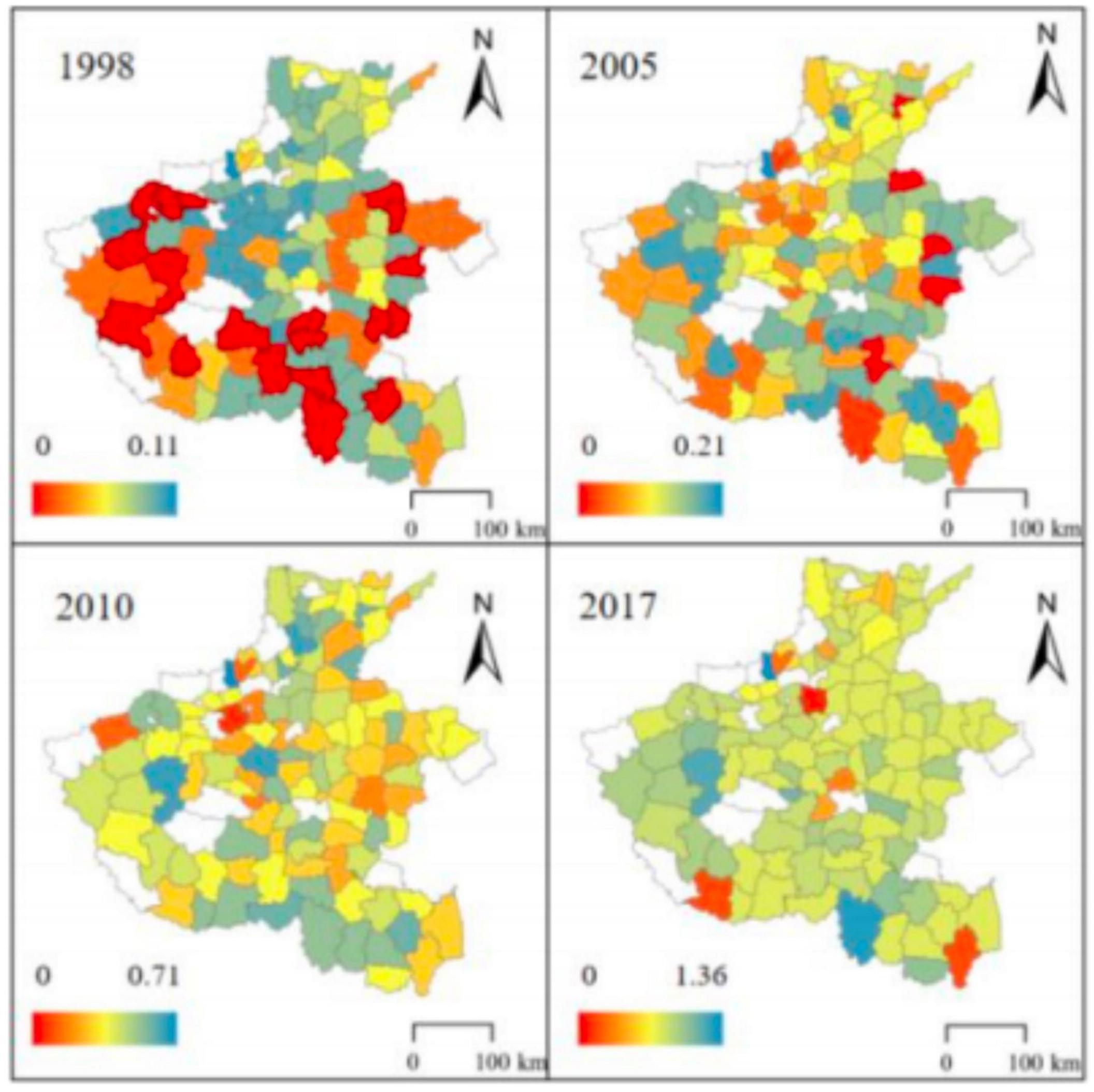
Figure 8. Spatial difference of economic contribution function of cultivated land in Henan Province.
Spatial Characteristics of Food Security Function
As shown in Figure 9, in 1998, with exceptions of Luoshan County in Xinyang City, Sanmenxia City, and some counties and districts in Zhengzhou City, the counties and districts of Henan Province had a low food security function. In 2004, significant downward trends were observed in Shangcai County of Zhumadian City (from 0.07 to 0.04) and Neixiang County of Nanyang City (from 0.05 to 0.02). In 2010, the overall food security of cultivated land in Henan Province was weak. Specifically, Zhengyang County of Zhumadian City, Yexian County, and Jiaxian County of Pingdingshan City had the lowest food security function value. In 2017, the food security function value of Huaibin and Shangcheng counties of Xinyang City, Dengzhou City and Tanghe County of Nanyang City, and Weihui and Changyuan counties of Xinxiang City increased to varying degrees, with Changyuan County showing the most significant increase. Henan Province, as a traditionally important food province, continued to occupy an important position in China’s food security. Nevertheless, China’s food security function remained at a low level from 1998 to 2018, and it was unable to meet the food needs of the country’s huge population.
Spatial Characteristics of Ecological Safety Maintenance
As shown in Figure 10, in 1998, the ecological safety maintenance function of cultivated land in Henan Province was strong in the north and weak in the south. Specifically, Xiuwu County and Boai County of Jiaozuo City, in the northern area, had relatively ecological safety maintenance function values, both in the range 0.2–0.24. In 2005, the ecological safety maintenance function changed a little, although it continued to show the trend of high in the north and low in the south. In particular, the ecological safety maintenance function values of cultivated land in Weishi and Tongxu counties of Kaifeng City were improved, from 0.02 to 0.03 and 0.04, respectively. In 2010, the ecological safety maintenance function values of cultivated land in the Tanghe and Xixia counties of Nanyang City increased significantly. In 2017, the ecological safety maintenance function values of cultivated land in Neixiang County of Nanyang City, Luanchuan County of Luoyang City, Gushi County of Xinyang City, and Shangcai County of Zhumadian City were relatively low, mainly in the range 0.006–0.013. On the whole, in 1998–2018, the ecological safety maintenance function of cultivated land in Henan Province fluctuated within a small range, showing a continuous downward trend.
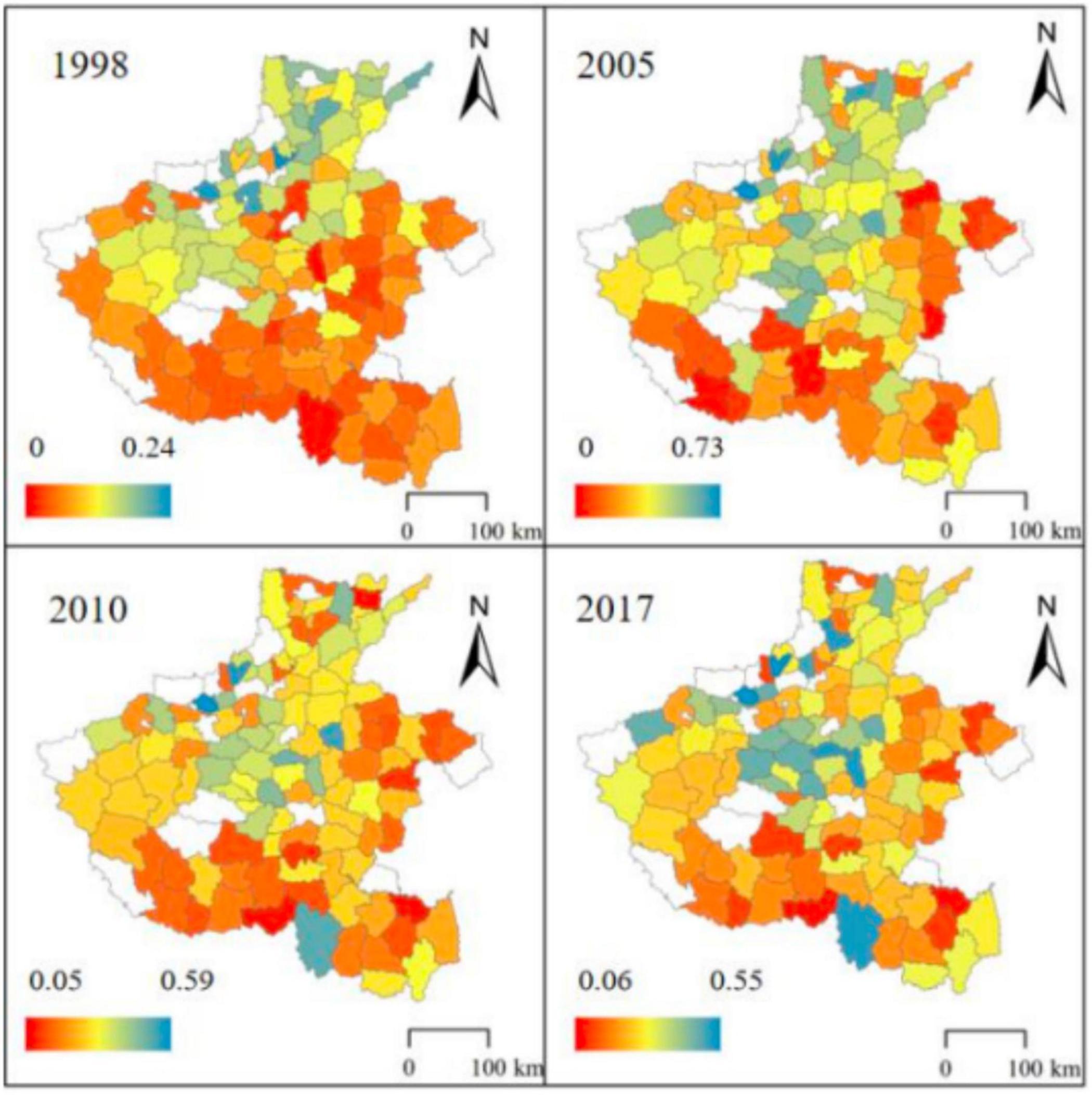
Figure 10. Spatial differences in the ecological safety maintenance function of cultivated land in Henan Province.
Analysis of Coordination, Trade-Off, and Driving Factors of Cultivated Land System Functions
Coordination of Cultivated Land Functions in Henan Province
Degree of coordination is an important indicator for measuring the coordination between the sub-functions and total functions of the cultivated land system. In the context of current high-quality development, people’s demands for cultivated land are increasingly diversified. This will apply or reduce external inputs to change various functions and the status of cultivated land. Thus, the cultivated land system is able to meet not only people’s ever-increasing material life needs but also the high-quality demands of ever-evolving spiritual life.
However, the production, job security, economic contribution, food security, and ecological safety maintenance functions of the cultivated land system are not synergistic with each other. This generates a synergy or trade-off relationship between the sub-functions and the total functions of the cultivated land system. Therefore, this study used the coordination analysis method to analyze the conflict and synergy relationship between sub-functions and total functions.
As shown in Figure 11, from 1998 to 2018, the coordination degree of cultivated land use in Henan Province fluctuated. Specifically, in 1998–2000, cultivated land use gradually developed from being uncoordinated to being basically coordinated. At this stage, the cultivated land system in Henan Province mainly fulfilled a production function, providing farmers with staple food crops. In 2000–2001, the cultivated land system was uncoordinated, and various sub-functions as well as the coordination degree of cultivated land use showed different degrees of decline. In 2002–2008, the coordination degree of cultivated land use improved gradually from uncoordinated to relatively coordinated status. In this period, Henan Province stayed in the transformation and development stage of the urbanization process, and the substantial cultivated land functions were production, job security, and economic contribution. As a basis for farmers’ work and employment, cultivated land provided not only production functions but also a primary livelihood and economic income for a majority of farmers. Cultivated land stayed at the primary stage and provided farmers with relatively basic functions.
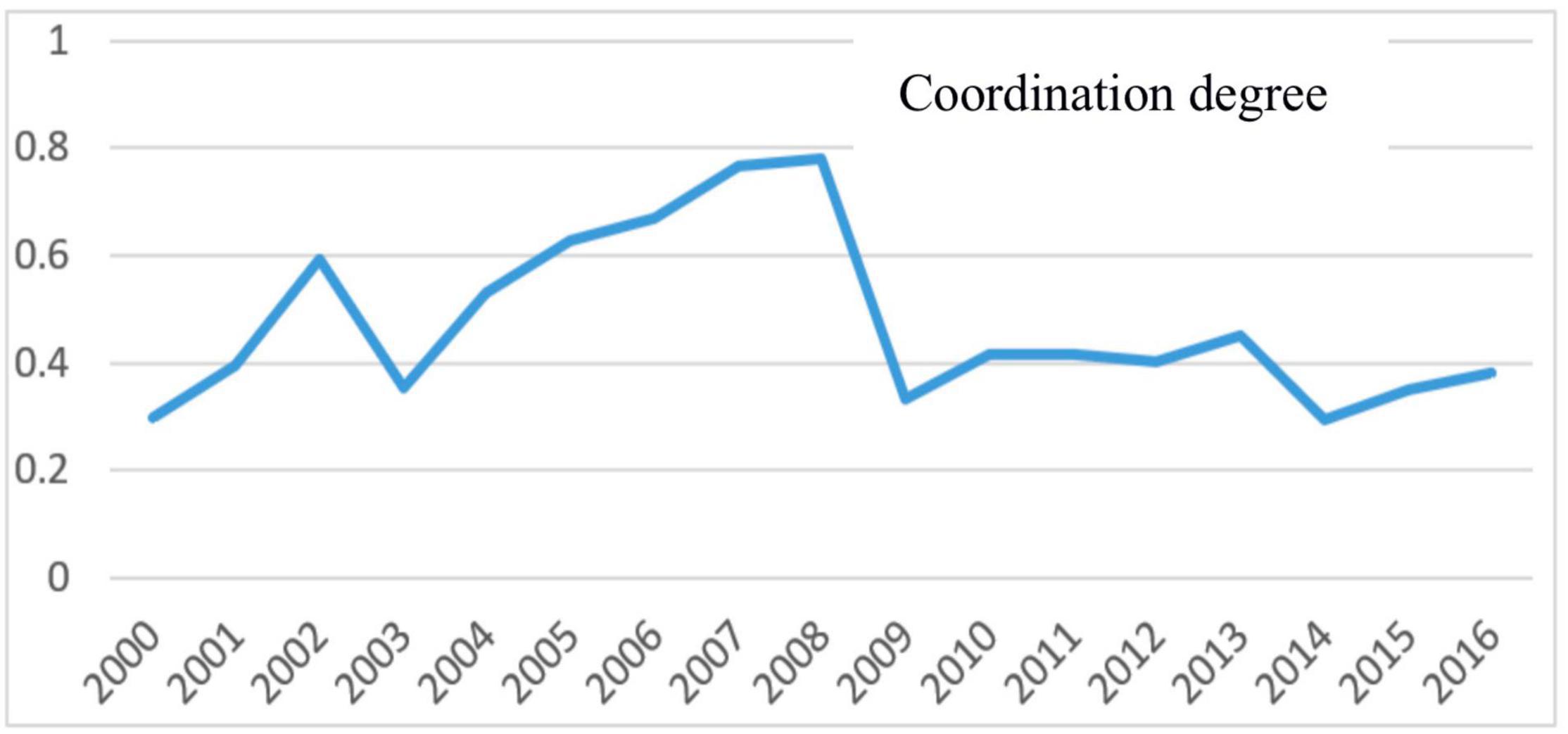
Figure 11. Analysis of degree of coordination between sub-functions and total functions of cultivated land in Henan Province.
After 2012, the system coordination degree fluctuated in an uncoordinated state. At this time, the coordination degree of cultivated land system came into conflict with the development trend of the ecological safety maintenance and job security functions; it was, however, consistent with the development trend of the economic contribution and production functions. In 2008–2009, the coordination degree of cultivated land use declined sharply and was in an uncoordinated state. Since 2010, the cultivated land system functions have been uncoordinated, reflecting agriculture’s weak position in regional development. The leading role of the production and job security functions of cultivated land has been affected by the social and economic development process. Furthermore, the decline of ecological function has had an impact on the overall function of the cultivated land system.
Driving Factors of the Cultivated Land Functions in Henan Province
In some cases, the degree of coordination reflects the root cause of the incoordination between the functions of the cultivated land system, which is not favorable for coordinating control goals and making specific decisions. We therefore used the gray correlation analysis method to analyze four aspects of the cultivated land system that have obvious effects, namely, population change, industrial structure adjustment, social and economic development, and ecological factors. We then used the gray correlation degree of related factors to identify the degree of influence of each factor on the cultivated land functions. In line with the results, we used nine indicators (see Table 2) to characterize separately the influencing factors of urbanization, industrialization, agricultural modernization, and agricultural policies on the evolution of cultivated land functions.
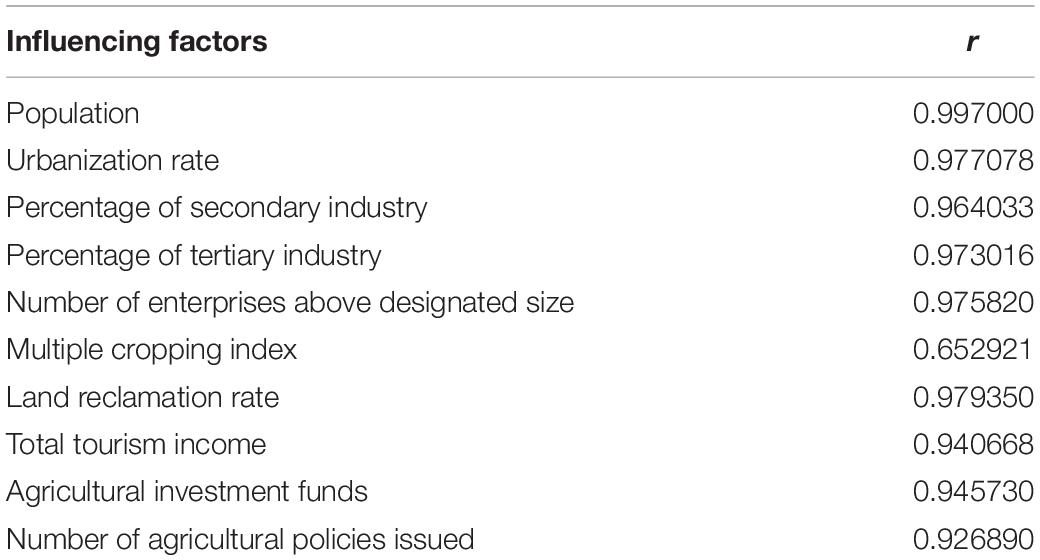
Table 2. Gray correlation degree between the evolution of cultivated land functions and social economic factors in Henan Province.
From the gray correlation model, when 0.8 ≤ r ≤ 1 the correlation degree is extremely high, when 0.6 ≤ r ≤ 0.8 the correlation degree is high, when 0.4 ≤ r ≤ 0.6 the correlation degree is medium, and when r < 0.4 the correlation is low. Table 3 shows that, except for the land reclamation rate having a low correlation with the evolution of cultivated land functions, other factors have an extremely high correlation with the evolution of cultivated land functions, and the highest correlation degree is the multiple cropping index.
(1) Demographic factors. Demographic factors have a strong influence on the evolution of cultivated land system functions. In 1998–2017, the urbanization rate of Henan Province increased substantially, mainly manifested as increase in the levels of land urbanization and population urbanization. On the one hand, in the process of urban development and expansion, agricultural land is constantly occupied, resulting in a continuous increase in the proportion of urban construction land. This leads inevitably to a continuous decline in the proportion of cultivated land, which indirectly reduces the food security and economic contribution functions of the cultivated land in Henan Province. On the other hand, in the process of urbanization, a large number of farmers enter cities to work, resulting in a continuous increase in the proportion of the urban population and an increase in demand for food and urban land. This requires sufficient cultivated land resources in rural areas to meet the increasing food demands of a huge population. As a result, the conflict between population, cultivated land, and food becomes more and more intense. Therefore, in the process of urbanization, it is necessary to guide the flow of the population to ensure an appropriate balance between urban and rural areas.
(2) Industrial structure factors. The gray correlation value of industrial structure factors is slightly lower than that of demographic factors. The adjustment of the industrial structure leads directly to changes in the land-use structure. With rapid economic development, the percentage of primary industry in GDP becomes lower and lower. In response, farmers move away from food crops with lower economic benefits toward cash crops with higher economic benefits. As a result, the planting area of grain is greatly reduced, whereas the planting areas of cash crops such as oil, fruit, vegetables, and tea increase significantly, and the main function of cultivated land transforms gradually from production and food security to economic contribution. The continuous development of secondary industry has increased the total industrial production value, and the demand for cultivated land increases year by year, which has promoted the evolution of the cultivated land functions to a certain extent.
To ensure further development, agriculture must integrate effectively with tertiary industry and develop further into tourism agriculture, which has a profound impact on the evolution of cultivated land functions. In recent years, the pastoral complexes, tourist towns, and picking gardens that have emerged in various places have had a significant impact on the adjustment of the industrial structure. Since the advent of COVID-19, primary industry has provided the ballast for the development of China’s national economy. In 2020, the added value of China’s primary industry reached 7,775.4 billion yuan, an increase of 3.0% year on year. Primary industry has been less affected by the COVID-19 epidemic and has had the fastest growth among the three industries. Although the proportion of the primary industry in GDP is low, it has a very strong effect on the development of the national economy and social stability.
(3) Agricultural modernization factors. Economic development is the lowest driving factor for the evolution of cultivated land functions. From the gray correlation analysis, we found that the cultivated land functions in Henan Province have gradually evolved from the original production and job security functions into economic-ecological coupling functions. This indicates that the agricultural modernization level in Henan Province has been increasing rapidly in the past 20 years, with the input of machinery and fund factors increasing year by year. The total output of cultivated land has increased, which has had an impact on the evolution of cultivated land functions, and funds are mainly being invested in upgrading agricultural technologies. In recent years, with the gradual application of a series of agricultural technologies such as crop rotation and soil testing, the diffused pollution of cultivated land has been effectively controlled.
When their incomes improve, farmers are more inclined to pursue high-level needs such as self-realization. This has a positive impact on agricultural science and technology, which directly affects the utilization efficiency and output of cultivated land. In addition, the input of agricultural mechanization has enabled agricultural production to be operated on a large scale, greatly reducing production costs and increasing the input–output ratio. Moreover, the development of agricultural science and technology enables the use of land that cannot be cultivated under the original technical conditions, expands the use of cultivated land, and allows the limited cultivated land resources to exert greater economic utility, thereby improving farmers’ enthusiasm and motivation to develop.
(4) Policy factors. Policy factors have been relatively low driving factors for the evolution of cultivated land functions. Constant reform of the rural land system has made the use of cultivated land more economic and intensive, and more empowerment will further improve the functions and efficiency of the cultivated land system.
Conclusion
Through our evaluation and analysis of the time series and spatial characteristics of the cultivated land system functions in Henan Province, we have identified the underlying characteristics of the multivariate changes in cultivated land system functions. The results of the multi-element comprehensive model yield six main conclusions.
(1) The transformation of the function of cultivated land is characterized by a clear stage and progressive nature. At different stages of social and economic development, people have different needs, and the functions of cultivated land change accordingly. The evolution of the functions of the cultivated land system in Henan Province over the past 21 years show that the functions of the cultivated land system are undergoing gradual improvement and also have clear stages. This reflects the fact that, before the 21st century, the objective of cultivated land is to protect both quantity and quality, and the function of cultivated land is to meet human needs for “eat well.” Meanwhile, the government gave farmers autonomous production rights through changes in the rural land system, which stimulated the production capacity of cultivated land and increased the production of staple foods, solving the problem of providing adequate food and clothing problem that had plagued China for decades. With the promulgation of the Law on Land Contract in Rural Areas in 2003, the abolition of agricultural taxes in 2005, and the implementation of the policy of industry refeeding agriculture in 2007, the living standards of residents have improved from having adequate food and clothing to eating well. These economic and social development trends generate diverse needs for cultivated land functions. Since 2013, the country has focused on the construction of an ecological civilization, the standard of living of the inhabitants has improved from eating well to paying more attention to the quality of life, and the function of cultivated land is being gradually improved with a clear progressive nature. During this period, in terms of the SDGs, the cultivated land transition goals has moved from the pursuit of “zero hunger” to the pursuit of “health and well-being.”
(2) The sub-functions of cultivated land system show a clear hierarchy. With the acceleration of urbanization and industrialization and in response to the high-quality economic development strategy, the functions of the cultivated land system have developed and diversified rapidly. However, there have been large differences between sub-functions. Specifically, the production function has increased rapidly at a high rate of increase. The economic contribution and food security functions have increased with some fluctuation, and the increase of economic function has been smaller. With the acceleration of urbanization, a large number of farmers have moved to cities and are living stable lives in urban areas, such that the job security function of cultivated land is gradually weakening. However, with the development of agricultural modernization, the increase in the use of chemical fertilizers, pesticides, machinery, and fossil-based raw materials in the cultivated land system has directly affected its ecological safety, leading to a decline in the ecological safety maintenance function. The cultivated land transition goals of “responsible consumption and production” should be focused.
(3) There are significant spatial differences in the changes of functions of the cultivated land system. The sub-functions of the 113 counties in Henan Province were quite different, and there were significant spatial differences in the sub-functions of cultivated land in the different periods under analysis (1998, 2005, 2010, and 2017). Before 2010, the production function was strong in the central and northern regions, and three mountains (Dabie Mountain, Funiu Mountain, and Taihang Mountain) in the western and southwestern regions were weaker. After 2010, most regions had strong production functions. The economic contribution function underwent small fluctuations, and the regional differences were not large, showing the weakness of agriculture in the development of the national economy. The food security function of the eastern plain area remained higher than that of the three mountain areas, and the job security function of cultivated land was on the whole weak. The ecological safety maintenance function was significantly stronger in the western and southwestern mountainous areas, while the southeastern region decreased gradually. The cultivated land transition goals of ‘reducing inequality’ needs more attention.
(4) The function of cultivated land systems is driven by multiple factors of change. The gray correlation analysis indicates that urbanization, industrialization, agricultural modernization, and agricultural policies are among these factors. Urbanization influences the functions of cultivated land system in two dimensions: improvements in land urbanization level and improvements in population urbanization level. With the improvement in land urbanization level, the urban area continues to expand, and cultivated land is occupied, which indirectly reduces the food security and economic contribution functions of cultivated land. The improvement in the population urbanization level increases the demand for food and the supply of resources, intensifying the conflict between population, cultivated land, and food. Therefore, appropriately and orderly urbanization can promote the coordinated development of urban and rural areas. Both the adjustment of industrial structure and the improvement of agricultural modernization exert an effect on the functions of cultivated land system. Under the action of the national macro policy, factor input and structural adjustment have affected both the quantity and quality of the cultivated land system, directly changing its functional strength of the system. Social development and technological progress have promoted improvements in dietary structure and the adjustment of cultivated land use and planting structure, while also allowing changes in the structure of cultivated land use input, planting structure, and type structure. This leads to production substitution and drives the gradual transformation of cultivated land use from a social type to an economic-social-ecological coupling type.
(5) There are synergies and trade-offs between the sub-functions of cultivated land. The synergy of multiple factors plays an important role in driving the evolution of the functions of the cultivated land system. The social and ecological elements in the cultivated system interact with each other to form a synergy, mutual contribution, and trade-off relationship between man and land, man and nature, and man and society, while the interaction of various relationships promotes the operation and development of the system. Our coordination model analysis indicates that from 1998 to 2017, the degree of coordination of cultivated land use in Henan Province fluctuated. In the early stages, it developed gradually from uncoordinated to basically coordinated status, and it was uncoordinated for two time periods. Since 2010, the coordination degree of cultivated land use has gradually improved from being uncoordinated to being relatively coordinated, showing that there were trade-offs and synergy trends between the sub-functions. The production, economic contribution, and food security functions were synergistic, and are basically consistent with the change trend of the total function of the cultivated land system. In contrast, there was a trade-off relationship between the job security, the ecological safety maintenance, and other functions.
(6) The functions of cultivated land system can be classified as diversified, hierarchical, and integral, and the system includes sub-functions of different natures. The relationship between sub-functions is complex, involving both synergy and trade-offs. Together, these synergy and trade-off relationships promote the continuous evolution and development of the overall functions of the cultivated land system. By adopting appropriate policies and regulatory measures, increasing the coordination functions, and alleviating the conflict functions, people can promote the development of the overall functions of the cultivated land system in a benign and high-quality manner. This will enable ever-increasing human needs to be met, which is the ultimate goal of the development of the cultivated land SES.
This study proposes a specific explanatory framework of the multifunctionality of regional cultivated land systems in different stages, and further clarifies the processes and driving mechanisms of social-ecological system service functions under different land use types, which can provide decision support for ecosystem service management. Meanwhile, the results showed the synergy between the cultivated land function transformation goals and sustainable development goals at different stages. Therefore, this paper further argues that the dynamic balance and spatial coordination between the social and ecological systems of cultivated land could be an important principle for measuring regional sustainable development.
Data Availability Statement
The raw data supporting the conclusions of this article will be made available by the authors, without undue reservation.
Author Contributions
PN and YY contributed to conceptualization. JZ contributed to methodology. YY and JZ contributed to formal analysis. YY, PN, and JZ contributed to writing—original draft preparation. YY, JZ, PN, and YX contributed to writing—review and editing. YX contributed to visualization. PN contributed to funding acquisition. All authors have read and agreed to the published version of the manuscript.
Funding
This research is funded by China Postdoctoral Science Foundation No. 2021M701371 for the author PN.
Conflict of Interest
The authors declare that the research was conducted in the absence of any commercial or financial relationships that could be construed as a potential conflict of interest.
Publisher’s Note
All claims expressed in this article are solely those of the authors and do not necessarily represent those of their affiliated organizations, or those of the publisher, the editors and the reviewers. Any product that may be evaluated in this article, or claim that may be made by its manufacturer, is not guaranteed or endorsed by the publisher.
References
Berkes, F., Colding, J., and Folke, C. (2000). Rediscovery of traditional ecological knowledge as adaptive management. Ecol. Appl. 10, 1251–1262.
Cai, Y. L. (2001). The mechanisms of cropland conservation in Chinese rural transformation. Sci. Geogr. Sin. 21, 1–6.
Cai, Y. L., and Huo, Y. Q. (2006). Reevaluating cultivated land in China: method and case studies. Acta Geogr. Sin. 61, 1084–1092. doi: 10.3321/j.issn:0375-5444.2006.10.008
Chen, Q. Y., Zhang, W. K., and Yang, G. Y. (2021). Spatial differentiation and trade-offs and synergy relationship between multiple functions of cultivated land in Guangdong Province. Jiangsu Agric. Sci. 49, 212–218. doi: 10.15889/j.issn.1002-1302.2021.13.041
Du, G. M., Sun, X. B., and Wang, J. Y. (2016). Spatiotemporal patterns of multi-functionality of land use in Northeast China. Progress Geogr. 35, 232–244. doi: 10.18306/dlkxjz.2016.02.010
FAO (2021). The State of Food Security and Nutrition in the World. Available online at: http://www.fao.org/3/cb4474en/cb4474en.pdf (accessed November 01, 2021).
Feng, L., Jiang, Y., and Ye, J. P. (2013). Induced institutional change or imposed institutional change? Institutional change and regional difference of land reallocations in rural China. Econ. Res. J. 48, 18–57.
Gómez Sal, A., and González García, A. (2007). A comprehensive assessment of multifunctional agricultural land-use systems in Spain using a multi-dimensional evaluative model Agriculture. Ecosyst. Environ. 120, 82–91. doi: 10.1016/j.agee.2006.06.020
Han, C. F. (2019). The reform of China’s rural land system. Issues Agric. Econ. 1, 4–16. doi: 10.13246/j.cnki.iae.2019.01.001
Herzon, I., and Helenius, J. (2008). Agricultural drainage ditches, their biological importance and functioning. Biol. Conserv. 141, 1171–1183. doi: 10.1016/j.biocon.2008.03.005
Jepsen, M. R., Kuemmerle, T., Müller, D., Erb, K., Verburg, P. H., Haberl, H., et al. (2015). Transitions in European land-management regimes between 1800 and 2010. Land Use Policy 49, 53–64. doi: 10.1016/j.landusepol.2015.07.003
Jiang, G. H., Zhang, F. R., Kong, X. B., Zhao, H. F., and Zhou, D. Y. (2011). The different levels and the protection of multi-functions of cultivated land. China Land Sci. 8, 42–47.
John, R., Chen, J., Noormets, A., Xiao, X., Xu, J., Lu, N., et al. (2013). Modelling gross primary production in semi-arid Inner Mongolia using MODIS imagery and eddy covariance data, Int. J. Remote Sens. 34, 2829–2857. doi: 10.1080/01431161.2012.746483
Kong, X. Z. (2016). China’s rural land system: formation, evolution and perfection. Stud. Soc. Chinese Characteristics 4, 16–22.
Kuang, L. H., Ye, Y. C., Zhao, X. M., and Guo, X. (2018). Evaluation and obstacle factor diagnosis of cultivated land system security in Yingtan City based on the improved TOPSIS method. J. Nat. Resour. 33, 1627–1641. doi: 10.31497/zrzyxb.20170754
Li, J. Y., and Dong, Y. X. (2019). Coupling coordination degree analysis between multifunctionality and security of cultivated land at town scale in Zhuhai. Trop. Geogr. 39, 410–419. doi: 10.13284/j.cnki.rddl.003130
Liu, J. L., Liu, Y. S., and Li, Y. R. (2017). Classification evaluation and spatial-temporal analysis of “production-living-ecological” spaces in China. Acta Geogr. Sin. 72, 1290–1304. doi: 10.11821/dlxb201707013
Liu, Y. S., Liu, Y., and Chen, Y. F. (2011). Territorial multi-functionality evaluation and decision-making mechanism at county scale in China. Acta Geogr. Sin. 66, 1379–1389. doi: 10.3724/SP.J.1011.2011.00415
Luo, C., and Cai, Y. Y. (2016). The stage characteristics and spatial heterogeneity of cultivated land resource function evolution in agricultural producing areas of Hubei Province. Econ. Geogr. 36, 153–161. doi: 10.15957/j.cnki.jjdl.2016.03.021
Meng, Y., Wang, K., and Lin, Y. (2021). The role of land use transition on industrial pollution reduction in the context of innovation-driven: the case of 30 provinces in china. Land 10, 353. doi: 10.3390/land10040353
Mertz, O., and Merens, C. F. (2017). Land sparing and land sharing policies in developing countries drivers and linkages to scientific debates. World Dev. 98, 523–535. doi: 10.1016/j.worlddev.2017.05.002
Qin, S. Y., and Wang, Z. C. (2020). Multi-function evolutions of arable land and its driving forces based on different functional types of cities. Sci. Soil Water Conserv. 18, 94–102. doi: 10.16843/j.sswc.2020.04.011
Qin, S. Y., Guo, Y. X., and Tang, C. C. (2018). Evaluation and spatial difference analysis on the arable land multifunction in Changsha city. Sci. Survey. Mapp. 43, 50–56. doi: 10.16251/j.cnki.1009-2307.2018.11.009
Schlager, E., and Ostrom, E. (1992). Property rights regimes and natural resources: a conceptual analysis. Land Econ. 68, 249–262. doi: 10.1016/j.worlddev.2016.12.032
Shi, Y. Y., Zhao, H. F., Yun, W. J., Tang, H. Z., and Xu, Y. (2015). Analysis on spatial differentiation of arable land multifunction and socio-economic coordination model in Beijing. Resour. Sci. 37, 247–257.
Song, X. Q., and Ouyang, Z. (2012). Connotation of multifunctional cultivated land and its implications for cultivated land protection. Prog. Geogr. 31, 859–868. doi: 10.11820/dlkxjz.2012.07.004
Spalding, A. K. (2017). Exploring the evolution of land tenure and land use change in Panama: linking land policy with development outcomes. Land Use Policy 61, 543–552. doi: 10.1016/j.landusepol.2016.11.023
Walker, B., Carpenter, S., Anderies, J., Abel, N., Cumming, G., Janssen, M., et al. (2002). Resilience management in social-ecological systems: a working hypothesis for a participatory approach. Conserv. Ecol. 6:1.
Wang, J., Lin, Y., Glendinning, A., and Xu, Y. (2018). Land-use changes and land policies evolution in China’s urbanization processes. Land Use Policy 75, 375–387. doi: 10.1016/j.landusepol.2018.04.011
Wang, Y. H., Li, X. B., and Xin, L. J. (2020). Spatiotemporal evolution of the old-age security function of cultivated land assets for Chinese farmers in the past 30 years and its policy implications. Geogr. Res. 39, 956–969. doi: 10.11821/dlyj020190289
Wiggering, H., Dalchow, C., Glemnitz, M., Helming, K., Müller, K., Schultz, A., et al. (2006). Indicators for multifunctional land use—Linking socio-economic requirements with landscape potentials. Ecol. Indic. 6, 238–249. doi: 10.1016/j.ecolind.2005.08.014
Yang, X., and Tan, M. H. (2014). Spatial differences and evolution of arable land functions in Beijing. Geogr. Res. 33, 1106–1118. doi: 10.11821/dlyj201406011
Yoshida, S., Yagi, H., Kiminami, A., and Garrod, G. (2019). Farm diversification and sustainability of multifunctional peri-urban agriculture: entrepreneurial attributes of advanced diversification in Japan. Sustainability 11:2887. doi: 10.3390/su11102887
Yuan, H., Jiang, F., Liu, S. H., and Cai, J. M. (2007). The multi-function of agricultural land use and its evolvement in Beijing. J. Arid Land Resour. Environ. 21, 18–23. doi: 10.3969/j.issn.1003-7578.2007.10.004
Zhang, W. B., Zhang, Z. B., Dong, J. H., Zhang, H. L., Gao, F. W., and Gong, W. M. (2021). Transformation and driving forces of cultivated land utilization function from a multi-scale perspective in Gansu Province. Sci. Geogr. Sin. 41, 900–910. doi: 10.13249/j.cnki.sgs.2021.05.018
Zhang, Y. N., Long, H., Ge, D., Tu, S., and Qu, Y. (2018). Spatio-temporal characteristics and dynamic mechanism of cultivated land functions evolution in the Huang-Huai-Hai Plain. Acta Geogr. Sin. 73, 518–534.
Zhao, H. F., Zhang, F. R., and Xu, Y. Q. (2007). Urban residents’ needs-oriented functional protection of cultivated land in Beijing. Resour. Sci. 29, 56–62. doi: 10.3321/j.issn:1007-7588.2007.01.009
Zhen, L., Cao, S. Y., and Wei, Y. J. (2009). Land use functions: conceptual framework and application for China. Resour. Sci. 31, 544–551. doi: 10.3321/j.issn:1007-7588.2009.04.003
Zhu, C. M., Li, W. Y., and Du, Y. Y. (2020). Spatial-temporal change, trade-off and synergy relationships of cropland multifunctional value in Zhejiang Province, China. Trans. Chinese Soc. Agric. Eng. 36, 263–272. doi: 10.11975/j.issn.1002-6819.2020.14.032
Zou, L. L., Li, Y. R., Liu, Y. S., and Wang, J. Y. (2021). Theory building and empirical research of production-living-ecological function of cultivated land based on the elements. Geogr. Res. 40, 839–855. doi: 10.11821/dlyj020200400
Keywords: high-quality development, cultivated land system, cultivated land functions, multifunctional evolution, correlation degree
Citation: Niu P, Zhou J, Yang Y and Xia Y (2022) Evolution and Trade-Off in the Multifunctional Cultivated Land System in Henan Province, China: From the Perspective of the Social-Ecological System. Front. Ecol. Evol. 10:822807. doi: 10.3389/fevo.2022.822807
Received: 26 November 2021; Accepted: 04 April 2022;
Published: 26 April 2022.
Edited by:
Li Peng, Sichuan Normal University, ChinaReviewed by:
Sunil Nautiyal, Institute for Social and Economic Change, IndiaHao Zhang, Institute of Mountain Hazards and Environment (CAS), China
Copyright © 2022 Niu, Zhou, Yang and Xia. This is an open-access article distributed under the terms of the Creative Commons Attribution License (CC BY). The use, distribution or reproduction in other forums is permitted, provided the original author(s) and the copyright owner(s) are credited and that the original publication in this journal is cited, in accordance with accepted academic practice. No use, distribution or reproduction is permitted which does not comply with these terms.
*Correspondence: Yongfang Yang, eXlmbnBAaGVudS5lZHUuY24=
 Pu Niu
Pu Niu Jiaxin Zhou2
Jiaxin Zhou2